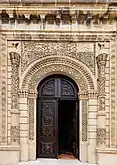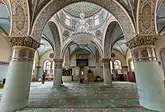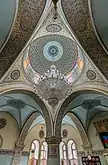Juma Mosque (Baku)
Juma Mosque (Azerbaijani: Cümə məscidi), or Friday Mosque, is a mosque in Baku, Azerbaijan.[1]
| Friday Mosque of Baku | |
|---|---|
Cümə Məscidi | |
 | |
| Religion | |
| Affiliation | Islam |
| Branch/tradition | Shia Islam |
| Location | |
| Location | Baku, Azerbaijan |
| Architecture | |
| Type | mosque |
| Style | Islamic architecture |
| Funded by | Haji Sheikhali Agha Dadashov |
| Date established | 1899 |
An inscription on the mosque mentions that “Amir Sharaf al-Din Mahmud ordered the restoration of this mosque in the month of Rajab 709 A.H. (1309)”. On the northern wall of the mosque a minaret was erected which a balcony supported by stalactites in the year of 1437.
Located in the historic Icheri Sheher, the mosque has been rebuilt several times. The present Friday Mosque was built in 1899 under the financing of Baku philanthropist merchant Haji Shikhlali Dadashov. There are traces of a Zoroastrian temple at the site.
In the cultural life of the medieval Azerbaijan the cathedral mosque served as socio-cultural centers. [2][3][4]
History
Jame Mosque
The Jame Mosque was built in the 12th century. A sophisticated design of the Mosque shows that it was built in several stages. Its main parts are a worship hall in the southern part and minarets in the north. There are small yards between the worship hall and the minarets. The most ancient part of the mosque is a square-shaped worship room. The room resembles kiosk mosques of the Seljuk period. Its cover was archaic. According to its exterior, this dome was constructed in style of the Maragha-Nakhchivan architectural school, which operated in the 12th century.
The ornamental motifs covering the upper part of the dome is found in Seljuk period architectural monuments such as minarets of Shamkir, Garabagh and Atabeklar complex, Maragha Red Gumbez (Dome) Tomb, etc.
Some scientists, in particular, Andrey Pavlinov, believed that the Juma Mosque was built on the remains of a temple of fire-worshipers.
.jpg.webp)
Minaret
In 1437, on the northern wall of the mosque, the stalactite-shaped minaret was built to call out the worshipers to namaz. On the inscription found in the archeological excavations of the minaret, the text of Mohammed Olcaytun's mourning, head of the Elkhanians, has been engraved.
Operating as a Madrasa
The rooms of the Jame Mosque were built in the 15th century for educational purposes in the yard of the Mosque. In the nineteenth century, the cells of the Mosque were destroyed due to expansion of A. Zeynalli Street and road construction and just one of them remained in order to be used as a mosque madrassa.
Construction of the Juma Mosque
The Juma Mosque was constructed in the remains of the Jame Mosque by Baku millionaire and philanthropist Haji Sheikhali Agha Dadashov in 1899.
The mosque operated as a carpet museum in the Soviet period. The Juma Mosque, which restored its activities as a mosque in the 1990s, was extensively repaired at the expense of the state budget.
The square-shaped worship hall with 4 columns in the central part of the Mosque and small dome are the main components of the Mosque. Oriental and European classic motifs have been used in the building's architecture. The portal is characterized by the typical features of Azerbaijani architecture: stone carvings, national patterns, artistic epigraphs, etc.
In 2008, by the construction specialists, architects and artists, the mosque was completely restored, heating and lighting systems were installed. On the walls of the mosque, hand-made ornaments, surah from Quran have been engraved and the names of the five members of the Ahl al-Bayt, who are sacred in Islam, were written.[5]
Gallery
 File:Juma_Mosque,_Baku,_2010.jpg
File:Juma_Mosque,_Baku,_2010.jpg.jpg.webp) File:Juma_Mosque,_Baku,_2010_(3).jpg
File:Juma_Mosque,_Baku,_2010_(3).jpg File:Mezquita_del_Viernes,_Baku,_Azerbaiyán,_2016-09-26,_DD_33.jpg
File:Mezquita_del_Viernes,_Baku,_Azerbaiyán,_2016-09-26,_DD_33.jpg File:Mezquita_del_Viernes,_Baku,_Azerbaiyán,_2016-09-26,_DD_34.jpg
File:Mezquita_del_Viernes,_Baku,_Azerbaiyán,_2016-09-26,_DD_34.jpg File:Mezquita_del_Viernes,_Baku,_Azerbaiyán,_2016-09-26,_DD_35.jpg
File:Mezquita_del_Viernes,_Baku,_Azerbaiyán,_2016-09-26,_DD_35.jpg File:Mezquita_del_Viernes,_Baku,_Azerbaiyán,_2016-09-28,_DD_36-38_HDR.jpg
File:Mezquita_del_Viernes,_Baku,_Azerbaiyán,_2016-09-28,_DD_36-38_HDR.jpg File:Mezquita_del_Viernes,_Baku,_Azerbaiyán,_2016-09-28,_DD_39-41_HDR.jpg
File:Mezquita_del_Viernes,_Baku,_Azerbaiyán,_2016-09-28,_DD_39-41_HDR.jpg File:Mezquita_del_Viernes,_Baku,_Azerbaiyán,_2016-09-28,_DD_42-44_HDR.jpg
File:Mezquita_del_Viernes,_Baku,_Azerbaiyán,_2016-09-28,_DD_42-44_HDR.jpg
References
- Леонид Семенович Бретаницкий. (1966). Зодчество Азербайджана XII-XV вв. и его место в архитектуре Переднего Востока. Главная редакция восточной литературы. p. 400.
- Джума мечеть (Ичери-Шехер, Баку)
- Л. С. Бретаницкий Баку Архитектурно художественные памятники 1956 стр.15
- Культовые сооружения Баку
- "Juma Mosque, Baku - Mosque in the Icheri-sheher".


